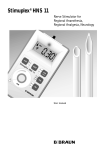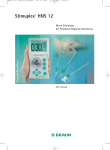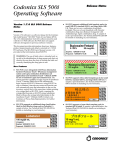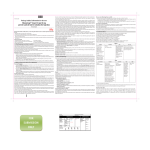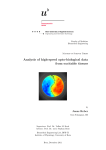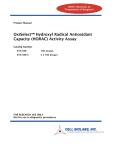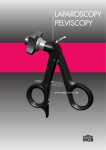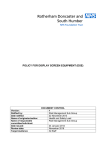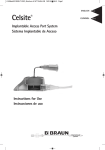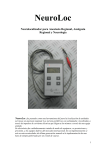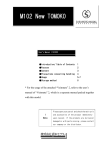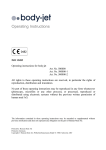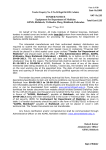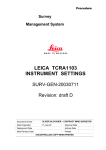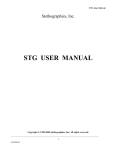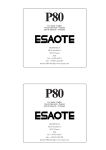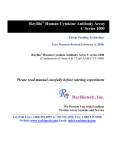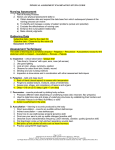Download Plexus Anaesthesia
Transcript
Plexus Anaesthesia Reliability and success with Stimuplex®, Contiplex® and Alphaplex® The leading edge in Plexus Anaesthesia Equipment. NEW TS PRODUCE INSID Plexus Anaesthesia Introduction to Brachial Plexus Block 2. Choice of LA by Dag E. Selander, MD, PhD, Gothenburg, Sweden The duration of surgery decides choice of LA. Short acting LAs are lido-, mepiva- and prilocaine with durations from 1.5–3 h, adrenaline 5 µg/ml prolongs duration with some 50 %. The long acting bupivacaine and ropivacaine may last from 5–10 h or more. It is important to inject a sufficient volume of the LA for a reliable block. For supra- and infraclavicular techniques 20–40 ml are needed, for axillary blocks 40–50 ml. Blockade of the brachial plexus with local anaesthetics can provide anaesthesia of the upper extremity, from the shoulder to the fingertips. Correctly performed, plexus block offers excellent regional anaesthesia and muscle relaxation for surgery and a method for long-term postoperative analgesia, both with minimal interference with the patient’s vital functions. The extent and duration of the block can be tailored to meet the needs required by the type of surgery and the patient’s condition, by selecting 1. the site of injection, 2. the local anaesthetic (LA), and, 3. the use of either a single shot or a continuous technique. In principal the same applies to plexus anaesthesia of the lower limbs. Besides skill and experience adequate injection equipment and local anaesthetics form the basis for an atraumatic and successfull plexus blockade. 1. Site of injection The neurovascular sheath which surrounds the brachial plexus and concomitant major blood vessels from the neck to the mid upper arm, allows blockade by a single injection into the sheath at three principal levels: supraclavicular (interscalene and subclavian perivascular), infraclavicular or axillary. There are several methods of identifying the brachial plexus e.g. eliciting a paraesthesia with the needle point, using a nerve stimulator or recognising the “click” as the needle enters the sheath. With practice, successrate will improve! 3. Continuous technique Using a continuous technique, surgical anaesthesia can be prolonged as needed, by intermittent bolus or continuous infusion of the LA. Regional postoperative analgesia can be extended for several days by similar administration of a low concentrated long acting LA, which will minimize motor blockade. With this technique, effective pain relief can be achieved without the side effects of opioids or other centrally acting analgesics. As sympathetic blockade will accompany sensory blockade, the limb will remain vasodilated, which is highly advantageous after replantation operations. For reliable and safe plexus blocks, the patient should be adequately monitored and only lightly sedated. The anaesthetist should be familiar with signs and symptoms of overdosage, and prepared to treat such situations. To avoid neural complications, peripheral nerves should be handled with care, i.e. use recommended LAs and short bevel needles, and try to avoid rough paraesthesiae. Developed and manufactured in strict accordance with the requirements of clinical practice: The B. Braun Range: ■ Stimuplex® Systems for ”single-shot“ technique with nerve stimulation: Stimuplex® HNS 11 nerve stimulator and Stimuplex® D needles, Stimuplex® Dig RC and Stimuplex® A needles ■ Contiplex® and Alphaplex® Sets for continuous blockade with and without nerve stimulation New: Contiplex® D 110 mm set with newly designed catheter 2 Peripheral Electrical Nerve Stimulation (PENS) Principles By simplifying the accurate location of peripheral nerves, peripheral electrical nerve stimulation (PENS) facilitates the performance of nerve and plexus blocks increasing their safety and reliability. The old rule ”no paraesthesia - no anaesthesia” loses its validity, because information from the patient concerning paraesthesia is eliminated, and the danger of a mechanical nerve lesion is largely excluded. The principle consists of triggering depolarizations with electrical pulses at, but not within, the nerve, causing muscular contractions at the effector muscle or sensitive sensations in the distribution area. Paraesthesia due to direct contact of injection needles and nerve is consciously avoided. PNS does not replace the anatomical knowledge required for regional anaesthesia, rather it assumes accurate knowledge of the topography and the nerve distribution area. The various types of nerve fibre differ in regard to their sensitivity to electrical stimulation. The A-alpha motor fibres have the shortest chronaxia (50 - 100 µs). The fibres of pain sensation (A-delta and C-fibres) require a longer pulse (150 and 400 µs respectively) at minimum current. Mixed peripheral nerves can be localized with short pulses (0.1 ms) without triggering pain sensations. For pure sensory nerves, a longer pulse (0.3 or 1.0 ms) is recommended. When using unipolar needles (needles with an insulated needle shaft and a conductive tip), the current necessary to trigger muscular contractions (= pulse amplitude) correlates with the distance of the tip of the needle from the nerve: the lower the threshold current the more accurately is the nerve localized, and the shorter the onset and more reliable the success of the block. Completely insulated needle Needle tip more distant from the nerve Completely insulated needle Basic of Electrical Nerve Stimulation Depolarisation, Threshold Level, Action Potential membrane potential U/mV High stimulus current Needle tip closer to the nerve High stimulus current High Speed Nerve Fibre action potential 20 time t/ms 0 Completely insulated needle -20 -40 -60 -80 theshold level depolarisation repolarisation resting potential Needle tip closer to the nerve Low stimulus current -100 The shorter the electrical pulse (= pulse width), the faster is the rise in current to the nerve, and the clearer the discrimination as to whether the needle tip is sufficiently close to the nerve. The stimulation needle should always be connected to the negative pole because higher currents are required if the polarity is reversed (needle positive). stimulus membrane potential U/mV Low Speed Nerve Fibre action potential 20 time t/ms 0 -20 -40 -60 -80 -100 stimulus depolarisation theshold level repolarisation resting potential The geometry of the electrical current field is dependent on the geometry of the conductive tip of the stimulation needle. The smaller the emission site of the electrons at the tip of the needle, the higher is the current density at this point and the lower the threshold current when the nerve is exactly localized. The B. Braun stimulators (Stimuplex® HNS 11 and the new Stimuplex® Dig RC) have been designed according to the most modern aspects and the requirements which originate from the theory and practice of peripheral electrical nerve stimulation. They are provided with alarm systems necessary for the early detection of technical faults which could endanger the patient and place the success of the anaesthesia in jeopardy. 3 W NE Stimuplex ® Dig RC / Stimuplex ® A needles System for ”single-shot“ technique with nerve stimulation. This Stimuplex® system is composed of the updated nerve stimulator Stimuplex® Dig RC with the option of nerve stimulation via Remote Control (RC) and a range of corresponding Stimuplex® needles with atraumatic short bevelled tips. The Stimuplex® system allows a very smooth and target-directed procedure to position the needle tip close to the nerve. In addition it is well tolerated by the patient because it is not necessary to elicit paraesthesia. Stimuplex® with its high level of safety by continuous feed back represents the ideal system for training in plexus blockade as well as for daily clinical routine. Your choice for upper and lower limbs. Stimuplex® DIG nerve stimulator Remote control for sterile one-hand-operation Only one knob for operation: ■ current setting and measuring at the same time without using an additional switch ■ yellow LED indicates every current pulse ■ flashing display if current flow is less than set current Simultaneous puncture and stimulation: ■ no coordination problems with assistance staff ■ more attention to the patient Impulse width 0.1 ms: ■ reliable stimulation of motor fibres without stimulation of afferent fibres (pain) Operation by two small “Up“- and “Down“-buttons only ■ tactile feeling combined with acoustic control Safe placement in the anaesthetist’s palm: ■ easy fixation with two finger rings ■ sterile handling due to a glove to be put on the usual way The new Remote Control RC is offered separately and available under code-no. 489 2216 B. Selectable impulse frequency ■ for most convenient and reliable stimulation NEW: Integrated electrode cable ■ more stable and integrated cable for better protection against damage ■ avoids inadvertent mix-ups with other cables (e.g. HNS 11) or its loss Technical Data Remote Control: Technical Data Stimuplex® Dig RC: Fixing: Impulse amplitude: Via finger rings on the palm Sterility: To be placed under the sterile glove Adjustment: Set required current value by pressing the buttons “Up“ or “Down“ Connection: Via steering-cable to the tripolar output socket on the front panel of the Stimuplex® Dig RC Case (Housing): Plastic Dimensions: 11.4 ✕ 7.2 ✕ 3.3 cm NEW: Extended acoustic control of the stimulus ■ optimum security during the entire performance Indications for Stimuplex® Dig RC/A Stimuplex® A needles ■ ideal for plexus blockades of the upper and lower limbs ■ especially suitable for plexus blockades of the lower limbs (e.g. 3 in 1 block) ■ nerve plexus blockades for patients who are not able to communicate and cooperate (e.g. sedated patients and patients under general anaesthesia) ■ extremely smooth gliding through all tissue layers ■ easily identifies the perivascular space by a distinct ”click“ ■ reduces the risk of nerve damage Impulse frequency: Impulse width: Digital display: Resolution: Output voltage: Battery: Electrode cable: Battery check: 0-5.0 mA constant current infinitely adjustable 1 Hz and 2 Hz, switchable 0.1 msec 3 digits from 0.2–4.99 mA 2 digits from 5.0 mA 0.01 mA 32 Vpp max. 9 volt, type 6 LR-61 or 6 F 22 integrated red LED Ergonomic needle hub: ■ allows precise needle guidance during puncture With special short bevel: The use of the Stimuplex® system for an inguinal paravascutar block of the lumbar plexus (3 in 1 block) Two options to adjust the stimulation current Via Remote Control RC ■ special socket to connect the new Remote Control RC or normal control knob ■ stimulation can also be done via the control knob Logarithmic current regulation ■ precise current adjustment especially in the low range around 0.2 mA Stimuplex® A needles with fully insulated needle shaft are available in 6 lengths with appropriate diameters Practice-proven lengths of electric cable and injection tube: ■ provide the necessary distance to the unsterile area ■ allows for aspiration and injection using the ”immobile needle“ technique Please note: Stimuplex® Dig RC nerve stimulator is also compatible with Stimuplex® D needles (see page 6/7) Stimuplex®-Feed back for high safety and success rates. 4 5 Stimuplex ® HNS 11 Stimuplex ® D “Single-shot” technique with new first-class technology Selectable stimulus duration offers either to selectively stimulate motor fibres of mixed nerves or to stimulate sensory fibres for locating pure sensory nerves. Precise measurement of the delivered stimulus current allows a very accurate positioning of the needle tip close to the nerve. The new Stimuplex® D needle with special coating features a non-cutting atraumatic bevel. The pin-point electrode supports optimal nerve localization. Stimuplex® HNS 11 nerve stimulator Stimplex® D needle The ideal pin point electrode ■ concetrates the entire stimulus current at the very needle tip ■ supports precise nerve loacalization at lowest threshold currents Switchable linear current ranges: ■ high resolution fine adjustment of stimulus amplitudes ■ especially suitable for technically sophisticated needles with pin-point electrodes ■ current ranges 0-1 mA and 0-5 mA Selectable pulse duration: ■ selective stimulation of motor fibres (0.1 ms) ■ additional stimulation of afferent fibres (1.0 mA) Acoustical and optical stimulus indication ■ excellent control an feed back of the stimulator functions Various alarm functions ■ avoid failure of the procedure in case of e. g. bad electric circuit, low battery, etc. bevel 30° 3 2 1 -10 0 +10 Distance to the nerve [mm] Special needle coating ■ localization of practically all mixed nerves for plexus and peripheral nerve blocks by selective stimulation of motor fibres without causing unpleasant sensations. ■ in addition, pure sensory nerves (e. g. lateral femoris cutaneous nerve) can be located using a longer pulse duration to stimulate sensory fibres. This is usefull for nerve blocks, e. g. in pain treatment. ■ homogeneous and smooth surface from hub to tip ■ smooth puncture with excellent tactile feed back ■ complete coating of the needle results in a atraumatic tip 6 Extremely narrow treshold curves provides 4 0 Indications for Stimuplex® HNS 11/D The use of Stimuplex system for the blockade of the lateral femoris cutaneous nerve by using pulse duration 1.0 mA bevel 15° Reizstrom [mA] The new nerve stimulator Stimuplex® HNS 11 in combination with Stimuplex® D, the latest generation of stimulation needles, provides high level safety and success rates. The high end in nerve stimulation Advantages from the latest digital technology Two different display modes ■ preset current (mA/current set mode), read actual current (mA/current read mode) Impedance check ■ check of electric circuit by comparing present and actual current values High accuracy stimulation ■ direct, high precision measurement of current ■ precise rectangular pulse shape For further details please refer to the user manual/instructions for use ■ excellent estimation of the distance between the needle tip and the nerve ■ most accurate needle positioning using lowest threshold currents Technical Data: Instrument type: Battery: Power consuption: Stimulation current: Stimulation voltage: Stimulation frequency: Measuring tolerance: BF 9V 3.3 mA max. 5 mApp / 0 Ω - 12 kΩ max. 65 Vpp 1 Hz / 2 Hz Adjustment control display = 3% (set point) Flowing current display = 2% (actual value) based on set mA values (5 mA or 1 mA) Wide range of different types and sizes ■ covers practically all indications in plexus anaesthesia ■ choice of 15° or 30° bevel according to your personal preference of puncture force and gliding characteristics Optional steam sterilizable control knob ■ convenient sterile operation of all functions ■ assisting staff is not necessary Stimuplex® HNS 11 and Stimuplex® D complement the well known and proven Stimuplex range with latest high-end technology. Full compatibility guaranted. Stimuplex® Feed back for high safety and success rates. Please note: Stimuplex® HNS 11 nerve stimulator is also compatible with Stimuplex® A needles (see page 4/5) 7 W NE Contiplex ® D / A Alphaplex ® The Contiplex® and Alphaplex® sets are offering special catheters and a modified 18G I.V. cannula with differently bevelled insulated needles according to your choice. Sets for continuous plexus blockades with and without nerve stimulation. Contiplex® D and A sets are available as catheter sets or as a single sterile cannulae. The Contiplex® D consists of the well-proven Stimuplex® needle with all the advantages mentioned before. These devices can be connected to a Stimuplex® nerve stimulator (HNS 11 or Dig RC) in order to gain the ideal position of the needle tip avoiding mechanical paraesthesia. The Contiplex® catheter which is made of the same polyamide material as the well-known Perifix® catheter provides all the advantages of a continuous technique. Special emphasis was laid on the tip forming process to create a smooth and atraumatic tip for the new Alphaplex® catheter. Contiplex® catheter The atraumatic tip design: ■ easy and atraumatic insertion as with the well-tried and proven Perifix® epidural catheter Approved polyamide material: ■ for prolonged implantation Contiplex® D cannulae Attached to both Contiplex® D and Alphaplex® sets: ■ Stimuplex® D needle design ■ simultaneous stimulation and aspiration/injection ■ available with 15° and 30° bevel to chose preferred puncture characteristics 8 Ideal for plexus blockade of the upper limbs. Alphaplex® sets with Seldinger wire and Contiplex® D cannulae are available in 4 different versions (see page 11). Seldinger guide-wire with highly flexible tip ■ atraumatic wire placement and safe catheter insertion New catheter tip design ■ smooth and atraumatic tip design Safe connection ■ kinking prevention due to the well-proven Perifix® catheter connector Indications for Contiplex® and Alphaplex® Alphaplex® catheter sets acc. to the Seldinger technique: Insertion of the catheter via the Seldinger wire ■ long duration anaesthesia for prolonged operations on upper limb ■ postoperative analgesia for as long as required ■ prolonged treatment for painful conditions such as reflex sympathetic dystrophy or cancer pain ■ a differential nerve block when required ■ optimal blood flow following replantations ■ excellent anaesthesia for hand operations and fractures of the radius ■ active physiotherapy without pain Contiplex® D catheter sets acc. to the Braunula technique: The threading assist guide allows easy insertion of the plexus catheter through the 18G I.V. catheter Contiplex® and Alphaplex® A real contribution to plexus blockade. Take your choice. 9 Product Identification The complete equipment on one glance Product Type Product Description Nerve Stimulators W NE Needles, cannulae and sets for peripheral nerve stimulation Canula (O. D. ✕ Length) Code Number Sales Unit Stimuplex® HNS 11, with electrode cable for Stimuplex® D-, Stimuplex® A- and Contiplex® D-needles 0489 2097 1 Stimuplex® DIG RC, with integrated electrode cable for Stimuplex® D-, Stimuplex® A- and Contiplex® D-needles 489 1996 B 1 0.5 ✕ 35 mm 0489 4103 25 D 25/055, 25 G ✕ 2 /8˝ 0.5 ✕ 55 mm 0489 4111 25 D 26/040, 23 G ✕ 11/2˝ 0.6 ✕ 40 mm 0489 4120 25 D 26/070, 23 G ✕ 23/4˝ 0.6 ✕ 70 mm 0489 4138 25 D 27/050, 22 G ✕ 2˝ 0.7 ✕ 50 mm 0489 4146 25 D 27/080, 22 G ✕ 31/8˝ 0.7 ✕ 80 mm 0489 4154 25 D 27/120, 22 G ✕ 43/4˝ 0.7 ✕ 120 mm 0489 4162 25 D 29/150, 20 G ✕ 6˝ 0.9 ✕ 150 mm 0489 4170 25 D 17/040, 22 G ✕ 11/2˝ 0.7 ✕ 40 mm 0489 4189 25 D 17/050, 22 G ✕ 2˝ 0.7 ✕ 50 mm 0489 4197 25 D 17/080, 22 G ✕ 31/8˝ 0.7 ✕ 80 mm 0489 4200 25 D 28/055/C, 18 G ✕ 21/8˝ 1.3 ✕ 55 mm 0489 4219 25 D 28/110/C, 18 G ✕ 43/8˝ 1.3 ✕ 110 mm 0489 4294 25 1.3 ✕ 55 mm 0489 4227 25 with cannula D 28/055/C, 18 G ✕ 21/8˝, 15˚ bevel 1.3 ✕ 55 mm 0489 4235 10 with cannula D 18/055/C, 18 G ✕ 21/8˝, 30˚ bevel 1.3 ✕ 55 mm 0489 4243 10 with Contiplex catheter 0.45 ✕ 0.85 ✕ 1000 mm 1.3 ✕ 110 mm 0489 4391 10 Stimuplex® D, needles with 15˚ bevel D 25/035, 25 G ✕ 11/3˝ 1 Stimuplex® D, needles with 30˚ bevel Contiplex® D, cannula with 15˚ bevel Contiplex® D, cannula with 30˚ bevel D 18/055/C, 18 G ✕ 21/8˝ Contiplex® D, Sets with Contiplex Catheter 0.45 ✕ 0.85 ✕ 400 mm W NE with cannula D 28/110/C, 18 G ✕ 43/8˝, 15˚ bevel 10 Product Type Product Description Canula (O. D. ✕ Length) Code Number Sales Unit Needles, cannulae and sets for peripheral nerve stimulation Stimuplex® A, needles with 30˚ bevel A 25, 24 G ✕ 1˝ 0.55 ✕ 25 mm 0489 4251 25 A 25, 22 G ✕ 1˝ 0.70 ✕ 25 mm 0489 4539 25 A 50, 22 G ✕ 2˝ 0.70 ✕ 50 mm 0489 4502 25 A 50, 21 G ✕ 2˝ 0.80 ✕ 50 mm 0489 4375 25 100 mm 0489 4260 25 0.90 ✕ 150 mm 0489 4278 25 18 G ✕ 13/4˝ 1.3 ✕ 45 mm 0489 3611 25 18 G ✕ 21/8˝ 1.3 ✕ 55 mm 0489 3643 25 with cannula 18 G ✕ 13/4˝ 1.3 ✕ 45 mm 0489 3603 10 with cannula 18 G ✕ 21/8˝ 1.3 ✕ 55 mm 0489 3638 10 Basic Set, 15˚ bevel 1.3 ✕ 55 mm U 180 0210 10 Super Set, 15˚ bevel 1.3 ✕ 55 mm U 180 0200 10 Basic Set, 30˚ bevel 1.3 ✕ 55 mm U 180 0201 10 Super Set, 30˚ bevel 1.3 ✕ 55 mm U 180 0203 10 24 G ✕ 1˝ 0.55 ✕ 25 mm 0489 1520 100 24 G ✕ 2˝ 0.55 ✕ 50 mm 0489 1562 100 0.75 ✕ 1.85 ✕ 230 mm 0489 1511 100 ➀ Electrode cable for Stimuplex® HNS 11 for Stimuplex® A-, D- and Contiplex® D-needles, length 125 cm 0489 2070 1 ➁ Electrode cable for Stimuplex® Dig RC for Stimuplex® A-, D- and Contiplex® D-needles, length 150 cm 489 2917 B 1 Remote Control for sterile one-hand-operation (especially for Stimuplex® DIG RC) 489 2216 B 1 Fingerrings (especially for Stimuplex® DIG RC) 489 2224 B 1 Knob for sterile handling (especially for Stimuplex® HNS 11) 0489 2089 5 Adaptor cable for Contiplex® A needle and electrode cable type ➀ or ➁ – Length 75 cm, autoclavable (up to 130˚= 234˚F) 0489 2925 1 Adaptor cable for needles other than B. Braun to fit ➀ or ➁ – suitable for almost all stimulation needles autoclavable (up to 130˚= 234˚F) 0489 2941 1 A 100, 21 G ✕ 4˝ A 150, 20 G ✕ 6˝ 0.80 ✕ Contiplex® A, cannulae with 30˚ bevel Contiplex® A, Set with Contiplex Catheter 0.45 ✕ 0.85 ✕ 400 mm W NE Set for ”Immobile Needle“ technique acc. to Winnie Alphaplex® Sets with catheter 0.9 ✕ 1.25 ✕ 330 mm, guide wire and Contiplex® D / D 28/055/C; 15˚ and 30˚ bevel Plexufix®, needle with 45˚ short bevel and extension tubing 0.75 ✕ 1.85 ✕ 300 mm Extension tubing for Plexufix® Accessories for plexus anaesthesia W NE 11 B. Braun Regional Anaesthesia Equipment Get the complete range Spinal Anaesthesia Spinocan® Needle for spinal anaesthesia, Quincke bevel Atraucan® Special needle for spinal anaesthesia Paediatric sizes Pencan Special needle with pencil point bevel Paediatric sizes Spinocath® Set for continuous spinal anaesthesia and pain treatment (CSA) Combined Spinal/Epidural Anaesthesia (CSE) Espocan® Set for spinal-epidural anaesthesia Epidural Anaesthesia Perifix®/Perifix® Soft Continuous epidural and caudal anaesthesia trays: – complete sets – sets with Loss of Resistance Device (L.O.R.)* – filter sets – mini sets – catheter, screw connector, L.O.R.* device Perifix® EF Epidural flat filter Perican® Needle with Tuohy bevel Perifix® L.O.R.* Low friction device for the L.O.R.* technique ® Perifix Paed/ Perican® Paed Paediatric epidural sets and needles *This low friction device has limited aspiration capabilities for use with fluids. Perifix® L.O.R. should not be used for injections of drugs. Literature Fischer, HBJ. (1996) Peripheral Nerve Blockade-Priniciples and Practice, 11–13 Churchill Livingstone Selander, D. et al. (1977) Peripheral nerve injury due to injection needles used for Regional Anaesthesia. Acta anaesth. scand. 21, 182–188 Klein, R. et al. (1994) The efficacy of an improved method for selectively placing a catheter for continuous axillary brachial plexus anaesthesia. Regional Anesthesia Vol. 19 No. 2 S: 74 Winnie, A. P. (1990) Perivascular techniques of brachial plexus block. Mediglobe SA Mehler, D., Otten, B. (1993) A new set of catheters for continuous axillary plexus block. Regional-Anaesthesie 6: 43 – 46 Zenz, M., Glockner, R. (1981) A new “immobile needle“ for brachial plexus block. Regional-Anaesthesie 4: 29–31 HOSPITAL CARE B. 03. 09. 00/1 Nr. 604 3437 Printed on chlorine-free bleached cellulose using 50 % recycled paper B. Braun Melsungen AG P.O.Box 1120 D-34209 Melsungen Tel +49-5661-71- 0 Fax +49-5661-71- 38 11 www.bbraun.com










